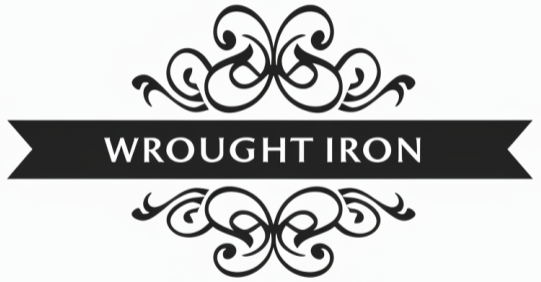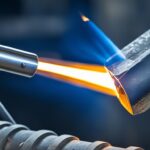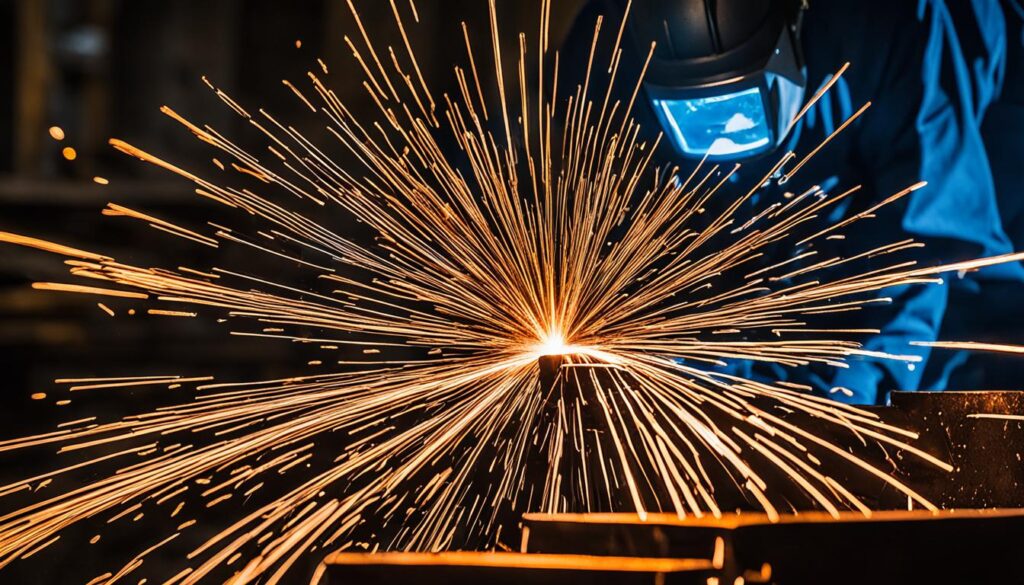
Picture standing in awe before the Palm House at Kew Gardens, a stunning wrought iron building from the 19th century1. Such landmarks are not just beautiful; they tell stories of the past1. Behind their beauty, skilled welders work hard to keep them standing. They fix and maintain these iron wonders, like the ironwork at Kew Gardens and the G-MEX Exhibition Centre in Manchester1. For these repairs, especially fighting corrosion near joints, companies like Posford Pavry and Partners are experts.
Key Takeaways
- Wrought iron structures often date back to the middle of the 19th century1.
- Iconic examples like the Palm House at Kew Gardens show the need for skilled wrought iron welding1.
- Corrosion near joints makes welding key for fixing wrought iron1.
- Companies like Posford Pavry and Partners are experts in complex restoration.
- Knowing how wrought iron works is key to welding it well.
Introduction to MIG Welding Wrought Iron
There’s a growing need for info on MIG welding wrought iron. This is because many old buildings from the 19th century need fixing. These buildings were made with bolted or riveted joints. Now, welding is often used to fix and strengthen them.
Wrought iron is known for being very flexible and strong. It was popular before steel took over. Knowing how to MIG weld wrought iron is key to keeping these old buildings safe and sound.
Cast iron is less common than steel but it’s tricky to weld because it’s brittle and not very flexible. It usually has 2-4% carbon, which affects its ability to bend and last long2. Wrought iron, on the other hand, is easier to weld because it behaves more consistently when heated.
Many people wonder, can you MIG weld wrought iron? Thanks to new welding methods, fixing wrought iron is now possible. Modern steel fillers and gas mixtures make the welding process reliable and strong.
Using MIG welding helps fix old wrought iron buildings effectively. It also makes sure these repairs last a long time. This way, we can keep our historical buildings safe with modern technology.
Wrought Iron Characteristics and Their Impact on Welding
Understanding wrought iron’s unique traits is key to getting great welds. This part looks into the metallurgical properties of wrought iron and the welding challenges it brings. Knowing these will help you make better choices when welding wrought iron, leading to strong and lasting results.
Metallurgical Properties
Wrought iron is a mix of rolled iron and refining slag with low carbon and sulfur. Its makeup is crucial for welding well. The way slag stringers are added during making affects welding a lot. This controlled slag makes wrought iron tough and flexible3. When welded right, wrought iron pieces look and work great.
Challenges in Welding Wrought Iron
Welding wrought iron comes with its own set of challenges, mainly because of its high oxygen and varied properties4. Old forge welding works well, but new methods like MIG welding might not always succeed4. To weld wrought iron, you need special filler wires with de-oxidizers like aluminum to control oxygen4. Slag in wrought iron makes picking the right welding methods crucial to avoid failures. Cleaning the metal well before painting, like using a wire wheel, helps stop rust and keeps wrought iron strong3. Checking metal structures often is a good idea to find problems early and plan fixes, keeping wrought iron in good shape for a long time5.
Can You MIG Weld Wrought Iron?
Yes, you can MIG weld wrought iron, but you need to be careful and use the right methods. Wrought iron has low-carbon content and a bit of sulphur, so special welding techniques are needed to avoid failures1. The strength of wrought iron can vary a lot, even in pieces from the same maker, so each welding job is different1.
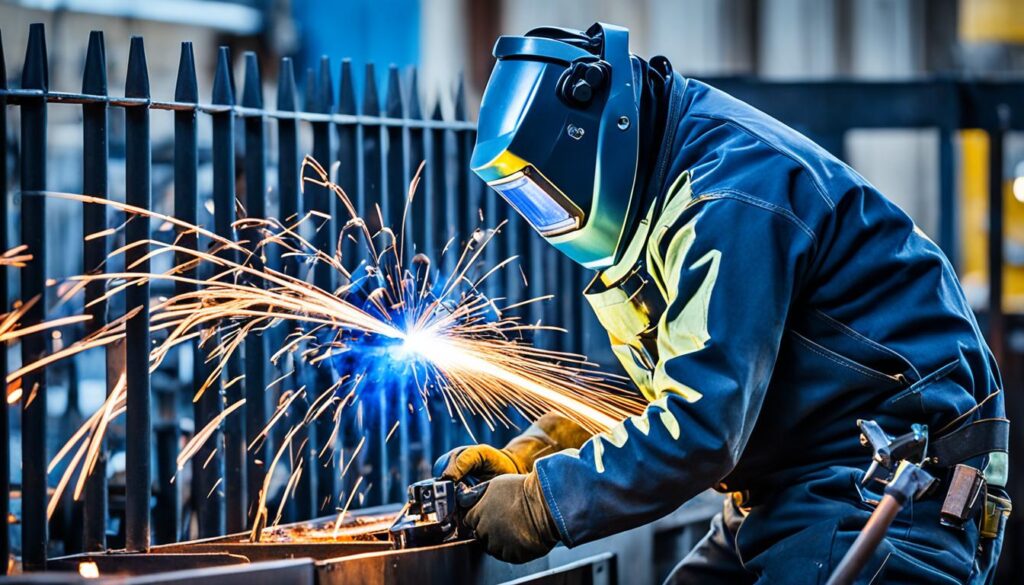
It’s a good idea to check the quality of the wrought iron before welding1. This helps make sure it’s good for welding. For the best results, use filler wires with certain elements like aluminum, silicon, and manganese to fight off the iron’s high oxygen content1. Also, warming up the wrought iron before welding can stop it from cracking6.
Wrought iron’s changing strength and the risk of lamellar tearing mean you have to be careful1. The right MIG welding methods can make strong, lasting welds. Plus, warming up cast iron pieces before welding, especially with wrought iron, helps prevent cracks and makes the weld stronger6.
By following these tips and picking the right filler wire, you can MIG weld wrought iron well. This ensures your welds are strong and last a long time.
Equipment and Materials Needed for MIG Welding Wrought Iron
When you’re MIG welding wrought iron, having the right gear is key for quality and durability.
Choosing the Right MIG Welder
Choosing the right MIG welder for wrought iron is vital. Aim for a welder with at least 200 amps to handle wrought iron’s heat. This power ensures deep penetration and even heat, keeping the wrought iron strong during welding.
Selecting the Appropriate Filler Wire
Picking the right filler wire is as crucial as the welder. Nickel-based alloys are top picks for their anti-cracking and anti-distortion properties. They make MIG welding of cast and wrought iron successful, creating strong welds. Also, wrought iron with low carbon and sulfur is easier to weld, thanks to these filler wires1.
Welding wrought iron often means using manual arc welding or rutile-coated electrodes. These help prevent oxidation and improve weld quality. Since wrought iron’s properties can vary, picking the right filler wire is key for consistent results1.
Here’s a table that compares MIG welding gear and filler materials for wrought iron:
| Equipment Type | Specification |
|---|---|
| MIG Welder | 200 amps output minimum |
| Filler Wire | Nickel-based alloy |
| Electrodes | Rutile-coated (BS EN 499 E38 X R XX or AWS E6013) |
Using the right MIG welding methods and tools will make your wrought iron projects strong and long-lasting. You’ll get the results you want with fewer issues71.
Shielding Gas Considerations
Choosing the right shielding gas is key for good MIG welding, especially for fixing wrought iron. A mix of 75% argon and 25% carbon dioxide (C25 gas) works well, giving a stable arc and quality welds8. Or, you can use 100% carbon dioxide (C100 gas) to save money, but it might make the weld spatter more8.
For wrought iron, getting deep welds and avoiding porosity is important. A 90% argon and 10% carbon dioxide (C10 gas) mix is great for this. It helps get a smooth arc, which is key for fixing wrought iron8.
Getting the shielding gas right helps stop porosity in the weld. Keeping the welding area clean is also crucial8. Also, make sure the distance between the tip and the work is right. This ensures the gas covers the weld properly, making it stronger8.
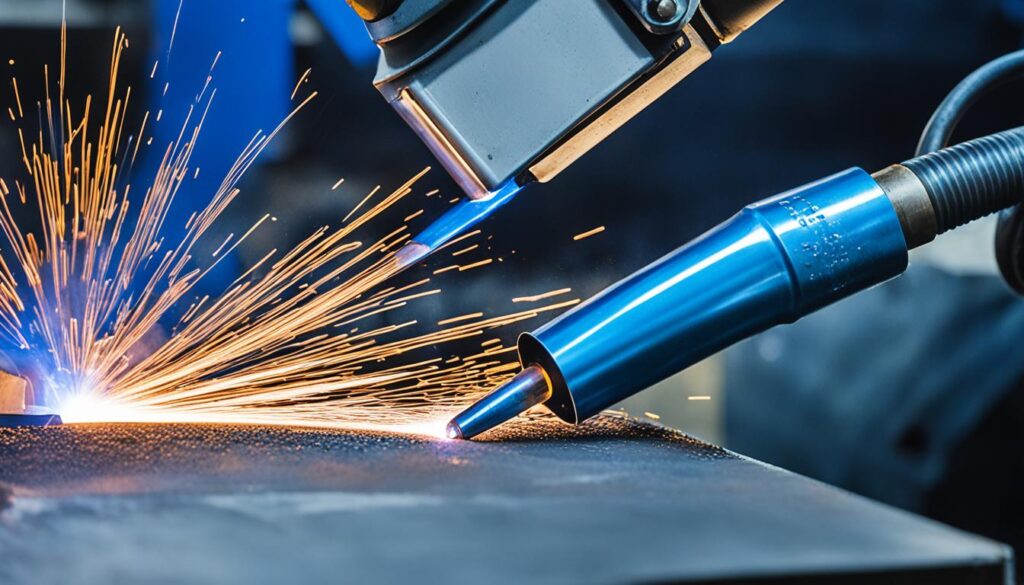
For special jobs, like fixing wrought iron with silicon bronze, use 100% argon gas. This keeps the weld clean and strong8. Picking the right shielding gas and setting it up right makes the weld look better and be stronger.
Here’s a look at different shielding gases and what they’re used for:
| Gas Mix | Composition | Application |
|---|---|---|
| C25 | 75% Argon/25% CO2 | Common for welding mild steel |
| C100 | 100% CO2 | Less expensive, more spatter |
| C10 | 90% Argon/10% CO2 | Spray transfer mode |
| 100% Argon | 100% Argon | Common for aluminum, silicon bronze |
| 98/2 Blend | 98% Argon/2% CO2 | Stainless steel welding |
Picking and using the right shielding gases for MIG welding is crucial for fixing wrought iron well.
Step-by-Step MIG Welding Techniques for Wrought Iron
To get good results with wrought iron welding, follow these step-by-step MIG welding steps. Start by picking the right filler wire, like a nickel-based one, which is great for welding iron910. Make sure to clean the wrought iron well to remove dirt, rust, or grease that could mess up the weld.
Then, heat the wrought iron to the right temperature. This is easy because wrought iron doesn’t need a lot of heat9. Set your MIG welder for a lower amperage to avoid too much heat. This helps prevent the metal from warping or distorting. MIG welding methods work well on different metals and make strong welds11.
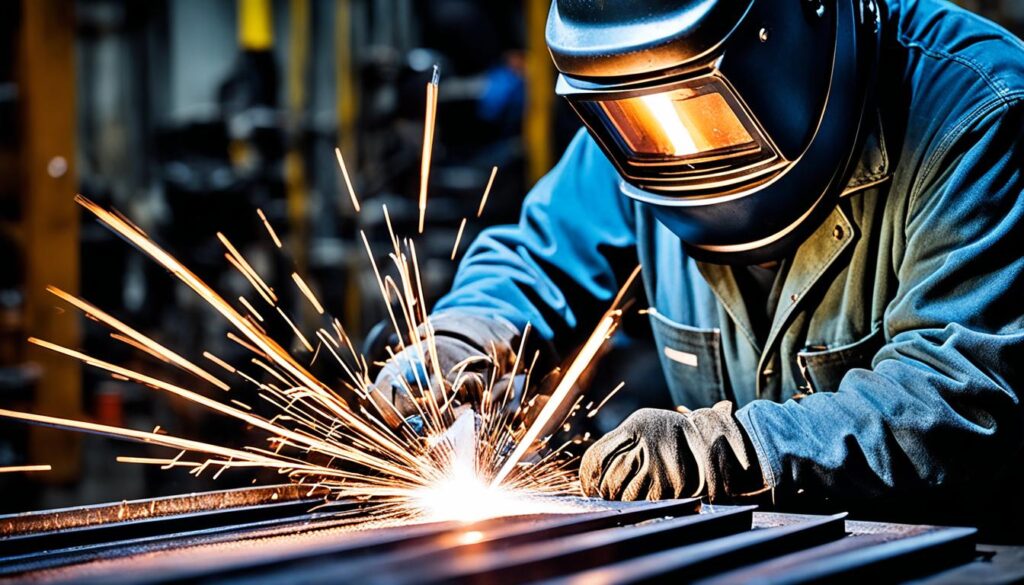
When welding, use a technique called “stitch welding”. This means welding in short bursts or stitches instead of a long bead. This helps control the heat and manage how the metal expands and contracts.
After welding, let the wrought iron cool down slowly. Quick cooling can make the metal brittle and prone to cracking9. Slow cooling is key to avoiding weld cracks and keeping the repair strong10.
By following these step-by-step MIG welding steps, you can do wrought iron welding well with a MIG welder. You’ll get strong, dependable joints for many uses.
Best Practices for Wrought Iron Repair and Restoration
When fixing wrought iron, it’s key to use the right welding methods for lasting results. Techniques like stringer beads and buttering help reduce welding stress. This makes sure the welds are strong, especially at key joints.
Repair Welding Methods
Heating the metal to 500 to 1200 degrees Fahrenheit before welding is crucial to avoid cracks12. Using 55% nickel rods is a smart choice for fixing steel and cast iron12. These methods make sure the repairs last longer and are reliable.
Restoring a historic 113-year-old railway station showed how important the right materials are for wrought iron repairs13. Techniques like GTAW control heat well, perfect for joining thick steel and ironless metals14.
Safety Precautions
Removing lead-based paints from old structures is a key safety step to avoid harmful fumes. Make sure your workspace is well-ventilated and use the right protective gear12. When using SMAW, be careful to avoid harmful noise, fumes, and emissions14.
| Welding Method | Suitability | Precautions |
|---|---|---|
| Stick Welding | Best for cast metals, minimizes carbon migration | Preheat between 500-1200°F12 |
| GTAW (TIG) | Combining thick sections of stainless steel | Requires precise heat regulation14 |
| FCAW | Can be done outdoors, efficient | Ensure proper ventilation14 |
Conclusion
Learning about MIG welding for wrought iron is key to getting strong and good-looking results. You need to know how the metal acts, which affects your welding. Preheat the metal to 500°F – 1200°F, based on its thickness, to avoid cracks15. Also, use a MIG welder with at least 200 amps to handle the metal’s heat15.
Choosing the right filler materials is important for wrought iron projects. Nickel-based alloys like ENiFe-CI and ENi-CI work well for strong welds15. The right shielding gas, such as argon and helium or argon and CO2, helps prevent weld porosity15. Short welding sessions and slow cooling can reduce cracking and stress15. Using bronze wire and argon gas might also improve your welding16.
Good practices are crucial for fixing and preserving wrought iron. Non-destructive tests like magnetic particle or ultrasonic testing check weld quality and keep the iron strong17. Joining cast and wrought iron with bolts, screws, or rivets is a smart move for some projects17. By following these MIG welding tips, you protect the iron’s history and beauty while making it last longer.
FAQ
Can you MIG weld wrought iron?
What challenges are associated with welding wrought iron?
What type of MIG welder is recommended for welding wrought iron?
Which filler wire is best for MIG welding wrought iron?
What shielding gas should be used for MIG welding wrought iron?
What are the best practices for repairing and restoring wrought iron with MIG welding?
What safety precautions should be taken when MIG welding wrought iron?
Source Links
- Can wrought iron be repaired by welding? – https://www.twi-global.com/technical-knowledge/faqs/faq-can-wrought-iron-be-repaired-by-welding
- How to Weld Cast Iron: MIG, TIG, Stick, and Arc Welding – Red-D-Arc – https://blog.red-d-arc.com/welding/how-weld-cast-iron/
- Welding Wrought Iron – https://weldingweb.com/vbb/threads/18541-Welding-Wrought-Iron
- Welding Wrought Iron? – https://www.practicalmachinist.com/forum/threads/welding-wrought-iron.293537/
- Conservation of Cast & Wrought Iron – https://fet.uwe.ac.uk/conweb/iron/iron_text/print.htm
- stick welding wrought iron railing – https://weldingweb.com/vbb/threads/262311-stick-welding-wrought-iron-railing
- What types of metals can you MIG weld? – https://esab.com/us/nam_en/esab-university/blogs/what-types-of-metals-can-you-mig-weld/
- What Gas Should You Use for MIG Welding in DIY Applications? – https://www.millerwelds.com/resources/article-library/what-gas-should-you-use-for-mig-welding-in-diy-applications
- How to Weld Cast Iron: Easy to Follow Steps & Tips | Welding Handbook – https://www.weldinghandbook.com/how-to-weld-cast-iron/
- How to Weld Cast Iron – https://www.reliance-foundry.com/blog/how-to-weld-cast-iron
- How to Weld – MIG Welding – https://www.instructables.com/How-to-Weld—MIG-Welding/
- Welding Cast Metals: Cast Iron, Cast Steel & More – Red-D-Arc – https://blog.red-d-arc.com/welding/welding-cast-iron-steel/
- Restoration question. – Welding Tips and Tricks – https://forum.weldingtipsandtricks.com/viewtopic.php?f=2&t=14883
- 3 Reasons to Use a Welder for Metal Furniture Restoration – https://www.samsweldinginc.com/3-reasons-to-use-a-welder-for-metal-furniture-restoration20cf5982
- How to Weld Cast Iron with a MIG Welder? – https://www.arccaptain.com/blogs/article/how-to-weld-cast-iron-with-a-mig
- welding and cast iron | Model Engineering Clearing House – https://modeleng.proboards.com/thread/13308/welding-cast-iron
- Can You Weld Cast Iron to Steel? A Comprehensive Guide – https://www.arccaptain.com/blogs/article/can-you-weld-cast-iron-to-steel
